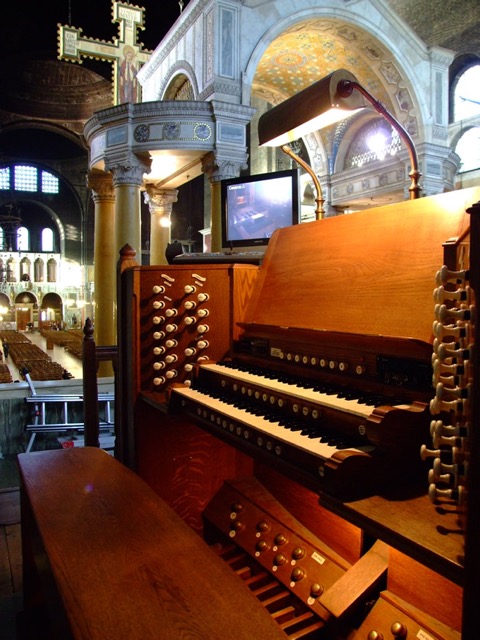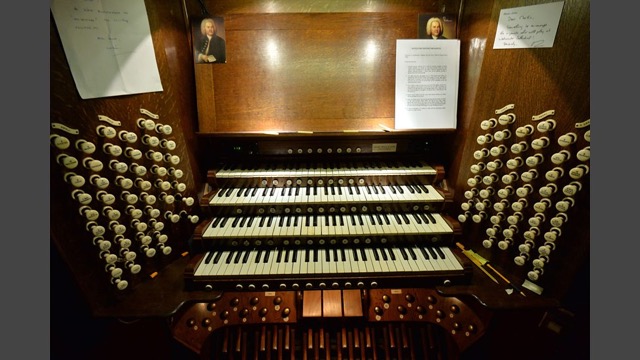The Organs of Westminster Cathedral
 Several recent visits to Westminster Cathedral have prompted me to write about the magnificent instrument installed in the west gallery. This, and its sister in Liverpool Cathedral, must rank as two of England’s finest 20th century organs. But the cathedral also has an Apse organ; and there were earlier instruments too.
Several recent visits to Westminster Cathedral have prompted me to write about the magnificent instrument installed in the west gallery. This, and its sister in Liverpool Cathedral, must rank as two of England’s finest 20th century organs. But the cathedral also has an Apse organ; and there were earlier instruments too.
The Casson Organ
The Divine Office was sung daily in the Cathedral Hall from Ascension Day 1902, a year before the Cathedral’s opening, accompanied by an 8 stop one-manual instrument constructed by The Positive Organ Company of Mornington Crescent, London. On the Cathedral’s completion the following year, the organ was placed on a trolley to move it between the Blessed Sacrament Chapel to the north of the sanctuary, and the Lady Chapel to the south. Eventually, it was fitted with an electric blower and installed in a gallery above the Vaughan Chantry in the north transept, where it remains; the pipes can just be seen from floor of the Nave. Whilst the organ was used to accompany liturgies in the Blessed Sacrament Chapel as recently as 1994, it is not currently in a playable condition.
The Norman and Beard Organ
On 6th June 1903, Elgar’s The Dream of Gerontius received its first London performance in the Cathedral, and for the occasion a large three-manual organ by Norman and Beard was hired at a cost of £100 per year. This instrument was installed in two sections in the gallery over the Archbishop’s throne, with a detached electric console that stood in the Apse. By 1907, however, the organ had been returned to the builders, and the TC Lewis Apse Organ was installed the same year.
The TC Lewis Apse Organ
The Apse Organ is housed in two wooden cases behind the High Altar. It was designed by Richard Terry, the first Master of Music, in 1906, and built by T C Lewis in 1907. The instrument was said to have been voiced so cleverly that organists who had heard the organ from the nave were astonished when they saw the true specification at the console. However, soon after its installation, the monthly Westminster Cathedral Chronicle commented on the Apse Organ’s inability to provide adequate support for the congregation, saying that it could ‘only be regarded as a temporary expedient’. The organ was altered by Henry Willis and Sons in 1926 to incorporate it within the project for the new west end Grand Organ.
 In 1984, the Apse Organ was rebuilt and enlarged by Harrison and Harrison. A total of eight new stops were added, and the Apse console was reduced to two manuals and re-sited on the South side of the Apse, giving the organist a view of the Nave and Sanctuary as well as the choir and conductor. Further work was carried out in 1996 to provide more levels of piston memories, and as a result, the general pistons of the new console can operate the memory banks of either the Grand or Apse organs, or both organs together. The Apse Organ is capable of accompanying the Cathedral Choir in its varied repertoire, as well as providing effective support for a congregation in the Nave.
In 1984, the Apse Organ was rebuilt and enlarged by Harrison and Harrison. A total of eight new stops were added, and the Apse console was reduced to two manuals and re-sited on the South side of the Apse, giving the organist a view of the Nave and Sanctuary as well as the choir and conductor. Further work was carried out in 1996 to provide more levels of piston memories, and as a result, the general pistons of the new console can operate the memory banks of either the Grand or Apse organs, or both organs together. The Apse Organ is capable of accompanying the Cathedral Choir in its varied repertoire, as well as providing effective support for a congregation in the Nave.
The Grand Organ
The earliest scheme for a new organ was proposed by T C Lewis in 1910 to a specification drawn up by Richard Terry. This proposal was for a large organ in several parts divided between the Apse and Tribunes. Largely for financial reasons, only the Choir Organ in the Apse was ever built. It was another ten years before Cardinal Bourne approached John Courage asking him to be the adviser on a new scheme for the Grand Organ. John Courage was an inspired choice; he had devised the specification for Southwark Anglican Cathedral, had served an apprenticeship with Lewis & Co, and was well acquainted with well-known international organists including Louis Vierne, Guy Weitz and Marcel Dupré. Dupré spent part of 1920 with Courage and had a great deal of influence on his ideas about the new organ. In particular, it was Dupré who insisted that the instrument should be at the west end as is common on the continent, rather than where Bentley, the Cathedral Architect, had intended it to be, in a position more typical of the English Cathedrals.
The first stage of the Grand Organ (only 33 stops) was inaugurated by Dupré in 1922. Over the next ten years, Dupré and others, including Reginald Goss-Custard, Edwin Lemare, Joseph Bonnet, Louis Vierne and Guy Weitz to name but a few, gave recitals that provided funds towards the gradual augmentation of the specification. In 1924 Marcel Dupré gave the première of his own Symphonie-Passion, for which the Pedal 32-foot Contra Bombarde was added.
 By 1932, work was completed, the specification now 11 stops larger than had originally been intended. Recitals were well attended, particularly those of Dupré, and continued until the outbreak of war in 1939. They resumed in 1946 with names such as Léonce de Saint-Martin, Fernando Germani, Jeanne Demessieux, and again, Marcel Dupré, whose tremendous association with the organ continued to flourish. In the early 1960s, Nicolas Kynaston restored the tradition of recitals after a lapse of some years, inviting many famous names to play, among them Germani, Ralph Downes, Jean Langlais, George Thalben-Ball, Pierre Cochereau and Jean Guillou. However, by then, the organ was in a state of severe deterioration; the action had become noisy, and maintenance had been seriously compromised ever since the addition in 1926 of a large electric console at the Apse to control both the Apse and the Grand Organs. This required the provision of 450 ft of electric cables and bulky electro-pneumatic conversion actions in an environment where space was already at a premium.
By 1932, work was completed, the specification now 11 stops larger than had originally been intended. Recitals were well attended, particularly those of Dupré, and continued until the outbreak of war in 1939. They resumed in 1946 with names such as Léonce de Saint-Martin, Fernando Germani, Jeanne Demessieux, and again, Marcel Dupré, whose tremendous association with the organ continued to flourish. In the early 1960s, Nicolas Kynaston restored the tradition of recitals after a lapse of some years, inviting many famous names to play, among them Germani, Ralph Downes, Jean Langlais, George Thalben-Ball, Pierre Cochereau and Jean Guillou. However, by then, the organ was in a state of severe deterioration; the action had become noisy, and maintenance had been seriously compromised ever since the addition in 1926 of a large electric console at the Apse to control both the Apse and the Grand Organs. This required the provision of 450 ft of electric cables and bulky electro-pneumatic conversion actions in an environment where space was already at a premium.
After a complete restoration, the organ was reopened in 1985 by David Hill, who was then Master of Music. The pipework was cleaned having lain for years under a thick blanket of dust and soot from candles and incense, and extensive revoicing was carried out where necessary. An eight-level solid-state capture system was installed, and the action was overhauled. Recently these improvements were continued with another overhaul of the action and with the installation of a 256-level capture system with a cross-channel advancer making registration changes much easier. The 1996 work also enables much fuller and more comprehensive use of the Grand Organ from the Apse console.
The Westminster Cathedral Grand Organ is considered by many to be the finest achievement and crowning glory of Henry Willis III, one of England’s great organ builders.
David Wakefield

